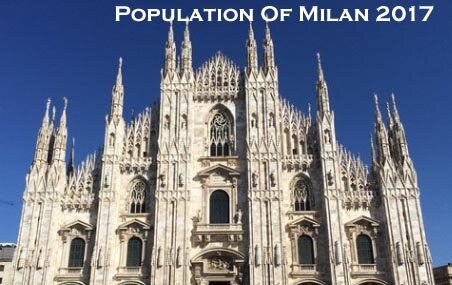Milan is the capital of the Lombardy locale and the most crowded metropolitan range. Milan is the principle modern and budgetary focal point of Italy and one of International importance. As far as GDP, it has the second biggest economy among EU cities and comes after Paris. Additionally, it the biggest among European non-capital urban communities. The city is considered part of the Blue Banana and it is situated at the center of one of the Four Motors for Europe.

The city’s business region has Italy’s Stock Exchange and the base camp of the biggest national and international organizations. The city is a noteworthy design and fashion capital, surely known for many global events and fairs, incorporating the Milan Fashion Week.
POPULATION OF MILAN IN 2017:
Talking about population, in order to check out the population of Milan in 2017, we need to have a look at the population of the past 5 years. They are as per the following:
- 2012 – 1.251 Million
- 2013 – 1.7 Million
- 2014 – 2.4 Million
- 2015 – 3 Million
- 2016 – 3.3 Million
Getting from the past data of Milan from the year 2012-16, it has been noticed that there has been an increase of 2.049 Million in the past 5 years. Therefore, it has been seen that every year the population increases by 0.4098 Million. Hence, the population of Milan in 2017 is estimated to be 3.3 Million + 0.4098 Million = 3.7098 Million. So, the population of Milan in the year 2017 as per estimated data = 3.7098 Million.
MILAN Population 2017 – 3.7098 Million(Estimated)
DEMOGRAPHY OF MILAN:
As indicated by reports, more than 200,000 inhabitants inside the city are from outside. It is no more bizarre to deluges of immigrants, having seen more than 400,000 people touch base all through the 1950s and 1970s, leading to additional growth in immigration amid the late 1980s. A significant part of the immigration has been credited to the quick industrialization and public works of Milan.
The city has the biggest community of Chinese in the nation, with around 21,000 Chinese occupants last recorded in 2011. There are additionally a developing number of Filipinos moving to Milan, with 2014 appraisals putting their numbers at 42,236. Other immigrants incorporate those originating from Africa and Latin America. The number of inhabitants in Milan is principally Catholic, despite the fact that there are likewise huge number of Buddhists, Muslims, Jews and Protestants.
POPULATION DENSITY AND GROWTH OF MILAN:
The population density of Milan is 7500 persons per square kilometer. Milan has been tormented with many years of a declining population, to some degree because of the budgetary emergency and industry decays. Be that as it may, the city is hinting at moderate growth, with city cutoff points of 1.7 million. The urban population is relied upon to see moderate yet dynamic growth throughout the years, with a 2020 evaluated population of 3.124 million and 3.16 million in 2030.
In 1950, the number of inhabitants in Milan was 1,883,000. The population growth rate has been on the slower side and it is expected that the pace of growth will be similar in the coming years.
FACTS ABOUT MILAN:
- There are just few remains of the old Roman state, strikingly the very much protected Colonne di San Lorenzo. Amid the second half of the fourth century, Saint Ambrose, as religious administrator of Milan, impacted the format of the city.
- The biggest parks in the central part of the city are Sempione Park and Montanelli Gardens, located in the northeast part of Milan.
- While Rome is the country’s political capital, Milan is the nation’s modern and monetary heart. Having a 2010 GDP assessed at €132.5 billion, the territory of Milan produces around 9% of the national GDP; the economy of the Lombardy creates roughly 20% of the country’s GDP.
- The city was influenced by the Baroque in the seventeenth and eighteenth century and facilitated various impressive painters, artists and architects, for example, Caravaggio and Francesco Hayez.
- Milan is generally viewed as an international capital in fashion, design and architecture. In the 60s, it was the primary industrial focal point of Italy and one of Europe’s most dynamic urban areas.



